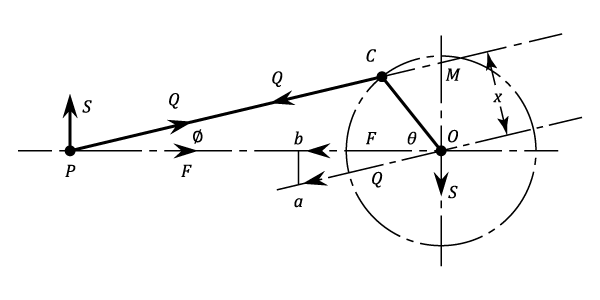Here ya go old man, more math than you could use in 20 years. Is this expounded enough??? ![]()
Reciprocating Masses
This force is provided by the pull of the connecting-rod and with reference to the following diagram:

- The connecting-rod is in tension and the force
 applied by the rod to the crank pin
applied by the rod to the crank pin  is equivalent to an equal and parallel force through
is equivalent to an equal and parallel force through  , together with a couple
, together with a couple  .
. .
. - The Couple
 .
. . tends to retard the rotation of the crankshaft and its effect is taken into account when finding the net turning moment on the crankshaft.
. tends to retard the rotation of the crankshaft and its effect is taken into account when finding the net turning moment on the crankshaft. - The force at
 is transmitted from the crankshaft through the main bearings and into the engine frame.
is transmitted from the crankshaft through the main bearings and into the engine frame. - Both the force at
 and that at
and that at  may be resolved parallel and perpendicular to the line of stroke. The horizontal components are equal and opposite.
may be resolved parallel and perpendicular to the line of stroke. The horizontal components are equal and opposite. - The one acting through
 accelerates the reciprocating parts.
accelerates the reciprocating parts. - The other through
 , is an unbalanced force applied to the frame and causes the frame to slide backwards and forwards on its mountings as the crank rotates.
, is an unbalanced force applied to the frame and causes the frame to slide backwards and forwards on its mountings as the crank rotates. - The two vertical components are equal and opposite and constitute a couple applied to the frame which attempts to rotate the frame in a clockwise sense.
Since
Also,
And
Therefore,
The full effect of the inertia of the reciprocating mass on the engine frame, is equivalent to a force ![]() along the line of stroke at
along the line of stroke at ![]() , and to the clockwise couple of magnitude
, and to the clockwise couple of magnitude ![]()
![]() .
.
 is called the Primary Force.
is called the Primary Force. which is called the Secondary Force
which is called the Secondary Force
It is clear that the primary force is equivalent to the component along the line of stroke of the centrifugal force due to an equal mass ![]() rotating with the crank and at crank radius. Consequently, in the case of a single-cylinder engine, the primary reciprocating force could be balanced by a rotating mass on the other side of the crank pin. However, this would introduce an unbalanced component of the centrifugal force of magnitude
rotating with the crank and at crank radius. Consequently, in the case of a single-cylinder engine, the primary reciprocating force could be balanced by a rotating mass on the other side of the crank pin. However, this would introduce an unbalanced component of the centrifugal force of magnitude ![]() perpendicular to the line of stroke. A compromise solution (partial balance) is usually applied, the inertia force being reduced to a minimum when 50% of the reciprocating mass is balanced.
perpendicular to the line of stroke. A compromise solution (partial balance) is usually applied, the inertia force being reduced to a minimum when 50% of the reciprocating mass is balanced.
The secondary force is similarly equivalent to the component of the centrifugal force of mass ![]() at radius of
at radius of ![]() rotating at
rotating at ![]() being coincident with the crank at inner dead-centre.
being coincident with the crank at inner dead-centre.





